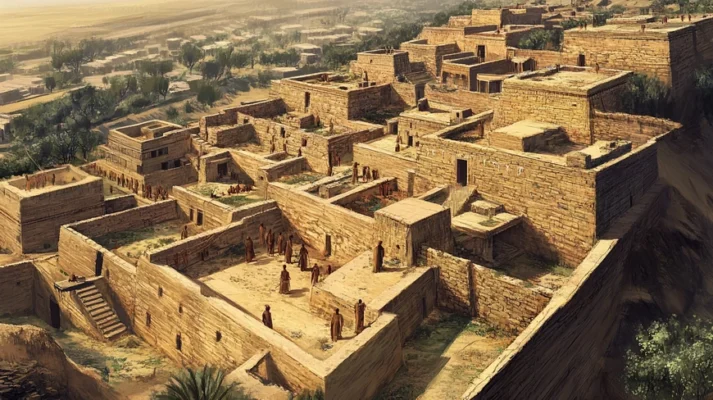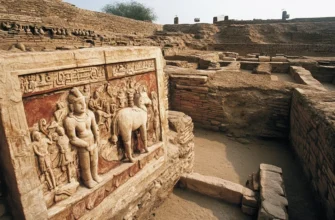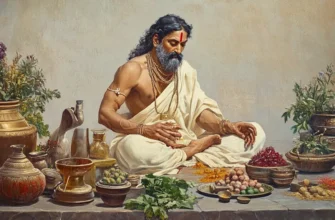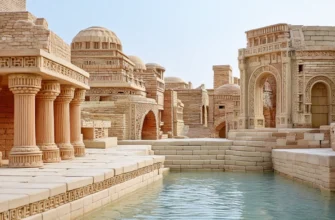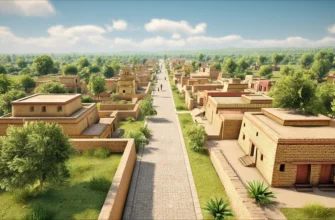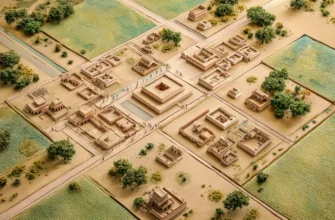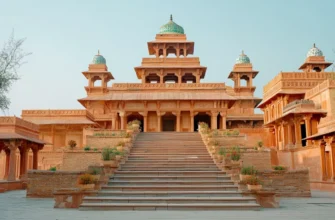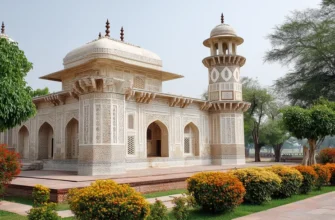The early period of the Harappan civilization (3300–2600 BC) marked the emergence of one of the oldest urban societies in South Asia. The civilization developed in the Indus River valley, where fertile soils favored the development of agriculture and animal husbandry. The population grew wheat, barley, cotton, and raised livestock.
The first settlements had a simple structure, but even at this time, fortified centers began to appear, indicating the formation of a social hierarchy. Craftsmen produced pottery, metal tools, jewelry, and textiles. Developed trade connected them with Mesopotamia and other regions.
Over time, small settlements grew, and well-planned urban centers appeared, marking the transition to a mature stage of civilization. It was during this period that the foundations of centralized government, writing, and developed infrastructure were laid, which later determined the character of the entire Harappan civilization.
- The origins of the Harappan civilization
- Main periods of development
- Geographical location and environment
- Indus Valley
- Features of society and culture
- Social structure
- Religious beliefs
- Connection to future religious traditions
- Writing and art
- Agriculture and farming
- Architecture and settlements
- Early cities and settlements
- Planning and infrastructure
- Building materials and technologies
- Decline and transition to the mature Harappan civilization
- Conclusions
The origins of the Harappan civilization
The origins of the Harappan civilization are linked to the development of early agricultural cultures in the Indus Valley, which emerged as early as the 4th millennium. It is believed to have been formed on the basis of local Neolithic traditions, in particular the Meghar culture, which existed in the region since the 7th millennium.
Over time, small agrarian settlements gradually evolved into complex urban centers. This was facilitated by favorable natural conditions, including fertile soils, access to water resources, and the development of irrigation systems. Contacts with other cultures, particularly Mesopotamia and Central Asia, may also have influenced the formation of civilization.
The Harappans created a unique system of urban planning, developed a complex social structure, and developed trade. Discussions about their ethnicity and language continue to this day, as the Harappan script remains undeciphered. The origin of this civilization is an important question for historians, as it helps to understand the origins of the first urban states on the Indian subcontinent.
Main periods of development
The Harappan civilization developed over several key periods, each marked by certain changes in society, economy, and culture.
- Early or Proto-Harappan period (3300–2600 BCE)
This period is characterized by the emergence of the first agricultural settlements in the Indus Valley. The population was engaged in agriculture, cattle breeding, crafts, and gradually formed a social hierarchy. The settlements had a simple structure, but fortified centers began to appear, indicating the growth of social organization. The first symbolic writing and trade links with neighboring regions emerged.
- Mature or classical period (2600–1900 BC)
This was the heyday of the Harappan civilization, when large cities such as Harappa, Mohenjo-Daro, Dholavira, and Lothal emerged. They were characterized by clear urban planning, centralized administration, developed trade, and water supply. Standardized bricks, drainage systems, and a weighing system were used. The civilization had active trade links with Mesopotamia, Persia, and the Central Asian region.
- Late or Decline Period (1900–1300 BCE)
This period was accompanied by a gradual decline in population and the decline of cities. The reasons for this may have been environmental changes, river course changes, the decline of trade, or invasions by outside groups. Cities gradually declined, the population moved to rural areas, and centralized administration and the writing system ceased to exist.
After its final decline, the Harappan civilization gradually assimilated into new cultural entities, in particular the Indo-Aryan societies, which began to form the Vedic civilization.
Geographical location and environment
The Harappan civilization was located in the valley of the Indus River and its tributaries, covering the territories of modern Pakistan, northwestern India, and part of Afghanistan.
The main cities emerged along the Indus, Ravi, and Ghaggar-Hakra rivers, which provided favorable conditions for agriculture, trade, and crafts. The warm climate with seasonal monsoons was conducive to the cultivation of crops, and an extensive irrigation system maintained high productivity.
The Indus River played a key role in the life of the civilization, providing fertile soil, water for domestic use, and transportation routes. The use of complex irrigation systems allowed the Harappans to make efficient use of natural resources, which contributed to the growth of cities and the development of crafts. The main centers of civilization were Harappa, Mohenjo-Daro, Dholavira, Lothal, and Rakhigarhi. Settlements stretched from Baluchistan in the west to the Ganges basin in the east, as well as to the coast of the Arabian Sea, which facilitated active maritime trade.
Thanks to its favorable geographical location, the Harappan civilization achieved a high level of development, but possible climate change and river course shifts in the late period may have caused its decline.
Indus Valley
The Indus Valley is one of the most important centers of ancient civilization, including the Harappan civilization, which existed from about 3300 to 1300 BC. Located in what is now Pakistan, India, and part of Afghanistan, it stretched along the Indus River and its tributaries, such as the Ravi, Jhelum, Chenab, Beas, and Sutlej. Thanks to its fertile soils and convenient geographical location, this region became an ideal place for the development of agriculture, crafts, and urban centers.
The climate of the Indus Valley in ancient times was warm and humid, which was conducive to agricultural production. The Indus River played a key role in the lives of the inhabitants, providing irrigation for fields, transportation, and trade. It was here that large cities such as Harappa and Mohenjo-Daro emerged, which had a developed urban planning system, drainage structures, and centralized administration.
In addition to agriculture, the inhabitants of the Indus Valley engaged in trade, establishing links with Mesopotamia, Persia, and Central Asia. The high level of development of engineering, architecture, and writing testifies to a complex social organization. However, around 1900 BC, the civilization began to decline, probably due to environmental changes, the disappearance of rivers, or external invasions. Despite this, the Indus Valley remains one of the most important archaeological regions, providing a deeper understanding of the development of ancient societies.
Features of society and culture
The society and culture of the Harappan civilization were very advanced for their time and had a number of distinctive features that indicate a high level of organization and culture.
The society was well structured, with signs of social hierarchy. Although the exact class structure is unknown due to the lack of a sufficiently clear writing system, archaeological data suggest that different social groups existed. Cities such as Harappa and Mohenjo-Daro had clear planning, fortified areas, drainage systems, and extensive trade links, indicating centralized management and a fairly developed administration. It is possible that leaders or rulers had significant power, but there is no direct evidence of a single monarch or centralized dynasty.
The culture of the Harappan civilization was multifaceted and highly developed. Archaeological finds show significant achievements in crafts such as weaving, metallurgy, pottery, and jewelry. The Harappans were skilled in making pottery, various bronze objects, and copperware. They also produced seals with symbols that were probably used to identify goods during trade.
The Harappan script, although still undeciphered, shows a high level of intellectual culture. The script was used on seals and clay tablets, indicating an organized system of administration and record keeping.
One of the most distinctive features of the Harappan culture was their urban planning. Cities were designed with a clear grid of streets, drainage systems, and palaces, indicating a highly organized society and a significant level of engineering development.
The religious practices of the Harappans are not known with certainty, but archaeological finds such as statues of gods and sacred animals may indicate polytheistic beliefs. Faunal symbols such as bulls, elephants, and fish are often found on artifacts.
Thus, the society of the Harappan civilization was highly developed, with a complex organization, advanced crafts, active trade, and a cultural heritage that continues to impress with its achievements to this day.
Social structure
The social structure of the Harappan civilization was quite complex and reflected a high level of social organization. Although the exact details of social classes are unknown due to the lack of deciphered writing, archaeological finds and urban planning features allow us to identify several key aspects of social organization.
The upper elite or ruling class
It is likely that there was a ruling class in society, whose members had significant power and control over the administration, economy, and religion. These may have been local rulers or victims of a centralized system of government. Their place in society was probably reflected in fortified areas of cities, such as palaces or special complexes in Mohenjo-Daro, where luxurious interiors and objects indicating social status have been preserved.
Merchants and craftsmen
This class probably played an important role in the economy and culture of the Harappan civilization. Merchants and craftsmen may have been organized into professional communities that produced a variety of goods, including pottery, textiles, bronze and copper artifacts, jewelry, and other household items. They also actively traded with neighboring cultures, including Mesopotamia.
Peasants and farmers
The majority of the population was probably made up of peasants and farmers who worked the fertile lands of the Indus Valley. They grew staple crops such as wheat, barley, and cotton, and also raised livestock. Agriculture was an important aspect of the economy and provided food resources for urban centers.
Slaves or dependent classes
Although there is no direct evidence of slavery in the Harappan civilization, some archaeologists suggest that lower classes may have been dependent on the upper classes, performing hard labor. Such individuals may have worked on large agricultural or construction projects or in urban workshops.
Religious and spiritual figures
The religious class, although little known, also played a role in society. Archaeological finds, such as statues of deities and religious symbols, indicate the existence of religious practices. Priests or other religious figures likely played an important role in ensuring the spiritual well-being of the community and may have had connections to elite power groups.
Women and families
Although the specific role of women in Harappan society is not fully understood, archaeological evidence suggests that women probably had certain social and economic functions. Statues of women and symbols associated with fertility are found among the artifacts, which may indicate the importance of women’s roles in religion and family life.
Overall, the social structure of the Harappan civilization was multi-layered and included various social groups, each of which played an important role in the development of the economy, culture, and governance.
Religious beliefs
The religious beliefs of the Harappan civilization remain one of the most mysterious aspects of this culture, as no accurate written sources have survived that could reveal their beliefs. However, archaeological finds and analysis of material cultures allow us to make some assumptions about their religious beliefs.
Pantheon of deities and worship
Archaeological research has uncovered numerous statuettes and symbols that are likely to have religious significance. Among the most famous are statuettes of women, which may symbolize goddesses of fertility, as well as various animals, such as bulls, elephants, and crocodiles, which probably had sacred significance. Particularly noteworthy are statuettes with reliefs of gods that may have been associated with natural elements such as water, earth, or fertility.
It is possible that the Harappans worshipped forces of nature such as water, sun, earth, and the elements. This is confirmed by numerous religious attributes, including images of animals associated with fertility or the protection of nature. The bull, for example, is one of the most common symbols on seals and statuettes, and may have been associated with deities controlling fertility and cattle breeding.
The Harappans probably had religious rituals associated with the worship of natural forces or deities. One possible evidence for this is the archaeological excavations at Mohenjo-Daro, where large pools were discovered that may have been used for ritual ablutions or other ceremonies. These structures may indicate the importance of water in religious practices.
Connection to future religious traditions
Although the specific religious beliefs of the Harappans remain unknown, some researchers believe that the religious ideas of the Harappan civilization may have influenced later Indian religions, particularly the Vedic tradition.
In particular, there is speculation that elements of deity worship and reverence for natural forces in the Harappan civilization formed the basis for Hindu beliefs that emerged in India.
Thus, although many aspects of the religious beliefs of the Harappans remain unknown, archaeological findings suggest that their religious life was closely linked to the worship of natural forces and symbols of fertility, which played an important role in their worldview.
Writing and art
Writing and art in the Harappan civilization played an important role in cultural and economic life. Although many aspects of these areas remain unclear, archaeological finds give us a general idea of the level of development of these areas.
Writing
The writing of the Harappan civilization is one of the greatest mysteries of archaeology. It was represented by a system of signs appearing on seals, clay tablets, and everyday objects. The writing was complex and contained hundreds of signs, which were probably used for administrative and commercial purposes.
However, unlike other ancient civilizations, such as Mesopotamia or Egypt, the writing of the Harappan civilization has not been deciphered, and therefore its exact meaning remains unknown. There are assumptions that it could have been logographic or even syllabic, meaning that each sign could represent a whole word or a specific sound.
Seals bearing these signs were used to mark goods and documents, indicating a high level of organization in trade and administrative management. Most seals depict various animals, such as bulls or bizarre creatures, which may have had religious or symbolic significance.
Art
The art of the Harappan civilization is characterized by great attention to detail and craftsmanship. This includes the manufacture of various objects such as statuettes, pottery, jewelry, seals, and other decorative items.
One of the most common forms of art were statuettes, many of which depict people, animals, and deities. Particularly noteworthy are statuettes of women, which may symbolize goddesses of fertility. There are also numerous depictions of animals, among which the bull occupies a special place, which may indicate its sacred significance for the Harappan culture.
Another important element of art was jewelry made from precious stones, metals, glass, and other materials. The Harappans produced beautiful necklaces, bracelets, and elaborate bronze and gold artifacts. This testifies to their high level of craftsmanship and technological achievements in the processing of metals and other materials.
Pottery was also an important part of material culture. The Harappans produced a variety of pottery, from simple pots to decorative items. Pottery was often decorated with geometric and abstract patterns, indicating a high level of aesthetic perception and artistic development.
Symbolism and styles
Harappan art often included various symbols and images that may have had religious or cultural significance. In addition to animals, abstract geometric ornaments are often found on seals and objects. These symbols and ornaments may have been used to decorate ritual objects or as markers of ownership and status.
Overall, the writing and art of the Harappan civilization testify to a high culture, advanced technical skills, and a complex system of social and religious beliefs. Although many aspects remain unclear, these achievements demonstrate a significant level of development in the fields of creativity, administrative management, and culture.
Economy and technology
The economy and technology of the Harappan civilization were very advanced for their time and reflected a complex and organized economy. The Harappans achieved significant success in agriculture, crafts, trade, and the development of technology, which allowed them to maintain a prosperous society.
Agriculture and farming
Agriculture was the basis of the Harappan civilization’s economy, providing the population with food and supporting the development of urban centers. The Harappans grew wheat, barley, cotton, rice, and other crops, which were the basis of their diet and trade. They also engaged in animal husbandry, raising cattle, sheep, goats, and possibly even elephants.
The irrigation system was an important part of the agricultural economy. The Harappans used sophisticated technologies to create irrigation canals, which allowed them to efficiently use the waters of the Indus River and its tributaries. This made it possible to maintain high yields despite seasonal monsoons and periodic droughts.
Crafts and manufacturing
The Harappans were skilled craftsmen in various trades.
Their pottery was known for its high quality and variety of shapes. They made dishes, decorative items, and other useful things out of clay. The people of Harappa were also skilled at working with metals—bronze and copper were used to make tools, weapons, jewelry, and even statues.
Textile production was also developed, and traces of cotton fabric production have been found in some cities. Weaving and textile production technologies were an important part of the economy, and cotton products could be exported to other regions.
Trade and economy
Trade was an important aspect of the Harappan civilization’s economy. Cities such as Mohenjo-Daro and Harappa were important trading centers that had connections with other ancient civilizations, such as Mesopotamia.
Goods traded included grain, textiles, cotton, precious stones, metals, and wood and metal products.
The Harappans used a system of seals to mark goods, indicating a well-organized administration and control over trade flows. This ensured order and transparency in trade, as well as guaranteeing the quality of goods.
Technology and engineering
The Harappans made significant progress in engineering and construction. Their cities were well planned with straight streets and complex drainage systems that allowed water to be effectively drained during rains. This indicates a developed urban infrastructure and attention to hygiene.
Irrigation systems deserve special attention. The Harappans used canals to divert water from rivers to agricultural fields, which allowed them to maintain crops during dry periods.
They also developed construction technologies. Cities such as Mohenjo-Daro had large buildings made of brick, as well as palaces and other administrative buildings. All buildings were constructed according to strict standards, indicating centralized organization and planning over large areas.
The economy and technology of the Harappan civilization were highly developed and contributed to the creation of a stable and prosperous culture. Their achievements in agriculture, crafts, trade, and engineering left an important mark on history, and many of these technologies remain impressive even by modern standards.
Architecture and settlements
The architecture and settlements of the Harappan civilization are notable for their high level of planning, spatial organization, and use of technologies that were advanced for their time. The cities of this culture had a clearly defined structure, indicating a complex social organization and developed infrastructure. Studies of architectural monuments allow us to reconstruct the image of urban life and understand how settlements were organized.
Urban planning
One of the characteristic features of the architecture of the Harappan civilization is its clear urban planning. This is most clearly seen in large cities such as Harappa and Mohenjo-Daro. The streets in the cities were straight and intersected at right angles, which facilitated movement and efficient use of space.
The cities were divided into two main parts: the upper city (citadel) and the lower city. The citadel was located on a hill and housed administrative, religious, and possibly palace buildings. The lower city was built for residential and commercial purposes and included numerous houses and workshops.
Buildings and infrastructure
Buildings in Harappan cities were constructed from fired bricks, which ensured their strength and durability. This allowed for the creation of multi-story houses and large structures that could withstand temperature fluctuations and retain heat during the cold months and coolness during the summer heat.
The cities also had a very well-developed infrastructure. One of the most famous architectural features is the complex water supply and drainage system. The cities had paved streets and drainage systems that allowed rainwater to be effectively drained away. Many houses had inner courtyards and water reservoirs, which shows how important water was for everyday life and hygiene.
Public buildings and religious sites
One of the most significant architectural structures in the Harappan cities are the large palaces and public buildings. A large structure was found in Mohenjo-Daro, which probably served as an administrative or religious center, as well as the so-called Great Pool, a large rectangular structure that could have been used for ritual ablutions or water storage.
Another important architectural feature is the numerous other religious structures, such as altars, statues, and places of worship. However, due to the lack of deciphered writing, the exact functions of religious buildings remain unknown, but it can be assumed that they were of great importance in religious and social practices.
Residential buildings
Residential buildings in the Harappan civilization varied in size and characteristics. They ranged from simple single-story buildings to more complex multi-unit structures with several rooms, inner courtyards, and sophisticated ventilation and water supply systems.
Architectural remains indicate that the houses were comfortable and functional, providing a comfortable life for different segments of the population.
Workshops and commercial areas
The lower city often housed a variety of craft workshops and commercial areas. These were specialized areas for the production of textiles, pottery, metalwork, and for the exchange of goods. Archaeological finds in these areas indicate the significant development of crafts and trade, which were an important part of the Harappan civilization’s economy.
The architecture of the Harappan civilization had a major impact on the development of urban planning and construction techniques in the future. The planning system, well-thought-out engineering solutions, and great attention to hygiene and comfort in residential buildings are impressive even by modern standards. This testifies to the high level of organization and technological development of this civilization.
Early cities and settlements
The early cities and settlements of the Harappan civilization were well planned and organized, with developed infrastructure and a high level of urban planning. The cities were well structured, with a clear division into different functional zones, which ensured comfort and efficiency in everyday life.
Some of the most famous and largest settlements of the Harappan civilization are Harappa and Mohenjo-Daro. These cities became centers of culture, administration, and trade, and their layout impresses even modern architects and urban planners.
Harappa
Harappa, one of the largest cities of the civilization, was located in the west of modern Pakistan. The city had a well-developed infrastructure with straight streets intersecting at right angles. The city was divided into two main parts: the citadel (the upper part of the city) and the lower city.
The citadel housed administrative and religious buildings, while the lower city contained residential quarters, workshops, and marketplaces.
Mohenjo-Daro
Mohenjo-Daro is another large and important city of the Harappan civilization, located in modern-day Pakistan. This city also had an organized structure with two main areas: the upper part, which was administrative, and the lower part, where the population lived. A large number of buildings have been preserved in Mohenjo-Daro, testifying to the high level of organization of the urban space, in particular the complex drainage systems used for water disposal.
Other settlements
In addition to Harappa and Mohenjo-Daro, archaeologists have found many other settlements of the Harappan civilization, such as Jungaro, Lotal, Kalibanagan, and others. Many of them were located along the Indus River and its tributaries, which allowed the use of water for irrigation and the development of agriculture.
Small settlements often had simpler layouts, but even there, well-organized streets, residential buildings with courtyards, and water supply systems can be observed. This indicates that even in smaller settlements, there were high standards of living.
Planning and infrastructure
The cities of the Harappan civilization were characterized by clear planning and well-thought-out infrastructure.
The streets were paved with bricks and ran at right angles, creating a clear division of territories. Buildings, particularly in Mohenjo-Daro, had drainage and sewage systems that allowed water to be effectively drained during rainfall, which is especially important in monsoon conditions.
Residential buildings had inner courtyards that could be used for domestic purposes or for storing water. Several large pools and reservoirs for storing water have also been discovered, indicating the great importance of water supply in these cities.
Cities as trade and cultural centers
The cities of the Harappan civilization served as trade and cultural centers. Thanks to their strategic location, they became important hubs in a trade network that covered a vast territory from Mesopotamia to central India.
Seals and markings found in the cities indicate a well-developed trade network. Craft workshops produced a variety of goods, from textiles to metalwork, and also specialized in the manufacture of jewelry and ceramics. Trade was conducted both within the city and with other civilizations, which contributed to cultural exchange.
The early cities and settlements of the Harappan civilization demonstrate a high level of urban development, engineering achievements, and social organization. The clear planning of cities, developed infrastructure, and trade networks indicate a high level of civilization that influenced the further development of urbanized societies in India and Pakistan.
Building materials and technologies
The building materials and technologies of the Harappan civilization testify to the high level of engineering and architectural achievements of that time. To create their cities and structures, the Harappans used a variety of materials and innovative techniques that allowed them to build durable and functional structures. This is undoubtedly one of the main reasons why their architectural achievements have survived to this day.
Brick and stone
The main building material in the Harappan civilization was fired brick. Brick structures became the basis for the construction of houses, palaces, city walls, water supply systems, and drainage channels. Bricks were made from local clay and fired in the sun or in kilns to ensure their strength. The use of bricks made it possible to create not only residential and public buildings, but also infrastructure for water supply.
In cities such as Mohenjo-Daro and Harappa, huge palaces and administrative buildings were built, the main material for which was also fired brick. In some cases, bricks of different sizes were even used, which made it possible to erect strong and durable walls.
Clay and wood
In addition to bricks, clay was used for some structures, serving to make pottery, such as tableware, as well as for building walls. Clay mixed with straw or other fibers could be used to create small structures or temporary dwellings.
Wood was used to make roofs and doors, as well as for interior decoration. Since wood was less durable, it was more often used for structures that were not subject to heavy loads.
Water supply and drainage systems
One of the greatest achievements of the Harappan civilization was the creation of complex water supply and drainage systems. Cities such as Mohenjo-Daro had a centralized water supply system that included large reservoirs for storing water, as well as individual water supply systems for houses.
Bricks and stones were used for drainage, creating underground channels to carry water away.
The sewage system was one of the most advanced in the world at that time and probably had no analogues among other ancient civilizations. This ensured high hygiene in cities and contributed to improving the living conditions of their inhabitants.
Other construction technologies
The construction technologies of the Harappan civilization also included the use of materials such as asphalt, which was used to cover streets and roads, as well as to seal canals. Other structural elements, such as stone slabs, were used to construct floors in palaces and public buildings.
The construction of palaces and public buildings also involved the use of large stone slabs to create floors or foundations. Stone processing technologies made it possible to create impressive imitations of stone structures, although brick remained the main building material.
Architectural solutions
Special attention should be paid to the architectural solutions developed, which took into account climatic conditions, comfort, and functionality. Buildings usually had large inner courtyards, which served for recreation or for storing water. Many houses had open verandas or balconies, which provided ventilation and shade on hot days.
In addition, some buildings were equipped with hydraulic systems that allowed for water flow control and flood protection.
The building materials and technologies of the Harappan civilization demonstrate an extremely high level of craftsmanship and engineering. The use of bricks, clay, stone, wood, and asphalt allowed for the creation of strong, functional, and durable buildings. Complex water supply and drainage systems, as well as well-thought-out urban planning, made the Harappan civilization one of the most advanced of its time.
Decline and transition to the mature Harappan civilization
The decline of the early Harappan civilization is a complex and poorly understood process, as archaeological sources do not provide a clear explanation for its decline.
However, based on excavations, analysis of material remains, and reconstructions of socio-economic conditions, several factors can be identified that may have caused the change in the early Harappan civilization and the transition to the mature phase.
The decline of the early Harappan civilization occurred around the middle of the third millennium BCE. The reasons for this process remain a subject of scientific debate. The most common theories are:
Climate change. One of the most likely causes of the decline is climate change. Rising temperatures or changes in monsoon patterns could have led to lower crop yields, causing famine and economic crisis. Changes in the water flow of the Indus River could have also worsened irrigation, which also affected agriculture.
Environmental disasters. Archaeological excavations have revealed traces of soil erosion, which could indicate environmental disasters caused by overexploitation of natural resources. This could have led to a decline in soil fertility and, consequently, to economic decline.
Social and political factors. Social divisions or internal conflicts may also have played a role in the decline of the civilization. Changes in the political system or growing social inequality may have weakened state control over cities, leading to their collapse.
Migration and invasion. Migrations of tribes from the north (such as the Aryans or other Indo-European peoples) may have had a negative impact on the stability of the Harappan civilization. Possible invasions or conquests of urban centers could have led to economic and cultural decline.
The revival of the Harappan civilization during its maturity in the middle of the third millennium BCE continued under slightly changed conditions. This period is characterized by the development of new technologies, improved urban planning, and the expansion of trade networks.
New centers of civilization. After the decline of early large settlements such as Harappa and Mohenjo-Daro, new trade and cultural centers developed, including Lothal, Kalibangan, and Jhangar. Although smaller in scale, these cities retained the main features of the Harappan civilization, including a complex infrastructure and a developed trade network.
Technological innovations. During the mature period of the Harappan civilization, considerable attention was paid to the development of technologies such as new methods of metalworking, particularly bronze. These technologies made it possible to manufacture more complex tools, weapons, and household items.
Trade and economy. Trade with other civilizations, particularly Mesopotamia, was an important part of the Harappan economy during its mature period. Archaeological finds confirm that the Harappans actively traded goods such as precious stones, metals, and textiles. A network of sea and land trade routes remained an important part of economic life.
Development of writing. The writing system of the Harappan civilization also underwent changes, and although it remains largely undeciphered, archaeologists have discovered new signs and symbols that may have been important for administrative and commercial transactions.
The decline of the early Harappan civilization was a multifaceted process involving a combination of environmental, social, and external factors. However, the transition to the mature Harappan civilization demonstrates the flexibility and adaptability of this society, its ability to adapt to new conditions and revive its economy and culture, albeit in a renewed form.
Conclusions
Conclusions about the Harappan civilization indicate its significance in the context of the development of ancient cultures and civilizations.
This civilization, which existed from approximately 3300 to 1300 BC, was one of the most developed in the world at that time, and its contribution to the development of urbanism, technology, art, and social organization cannot be underestimated.
First of all, the Harappan civilization was distinguished by its high level of urban planning, in particular its infrastructure, which included complex water supply and drainage systems. The construction technologies used to create cities and settlements testify to the high level of engineering and craftsmanship of the time.
Advanced agriculture, including irrigation systems, and trade with other civilizations were important components of this culture’s economic success. However, factors such as climate change, environmental disasters, possible invasions by other peoples, and social conflicts may have contributed to the decline of this civilization in its early period.
The transition to the mature Harappan civilization demonstrated its ability to adapt to new conditions while maintaining its key principles of urban planning, technology, and economy. The development of new trade and cultural centers and innovations in technology allowed the civilization to survive for several centuries.
In the end, the Harappan civilization was one of the largest and most advanced cultures of the ancient world, and although its decline remains partly a mystery, its achievements had a major impact on the further development of civilizations in South Asia and beyond.
